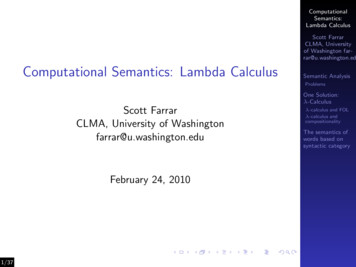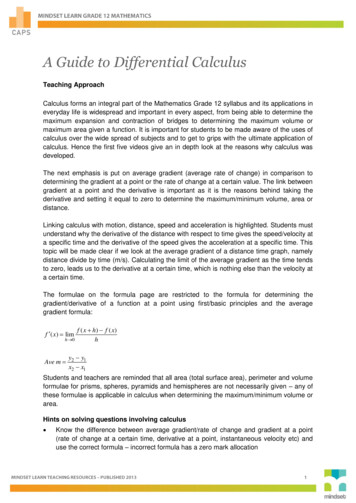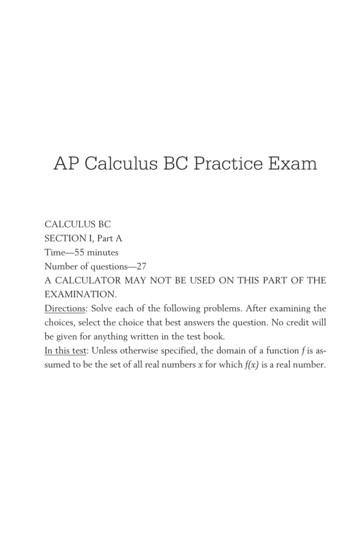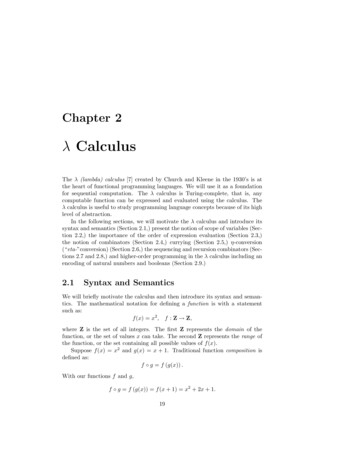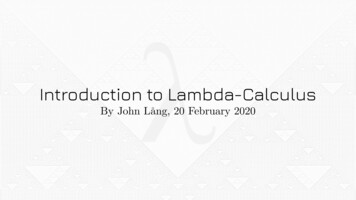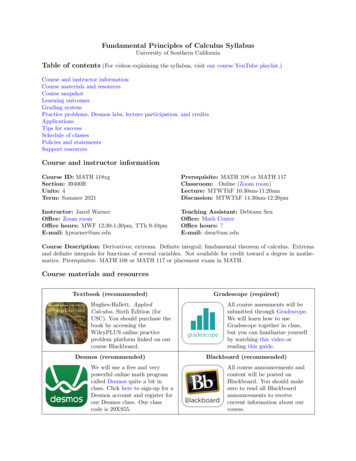
Transcription
Fundamental Principles of Calculus SyllabusUniversity of Southern CaliforniaTable of contents (For videos explaining the syllabus, visit our course YouTube playlist.)Course and instructor informationCourse materials and resourcesCourse snapshotLearning outcomesGrading systemPractice problems, Desmos labs, lecture participation, and creditsApplicationsTips for successSchedule of classesPolicies and statementsSupport resourcesCourse and instructor informationCourse ID: MATH 118xgSection: 39400RUnits: 4Term: Summer 2021Prerequisite: MATH 108 or MATH 117Classroom: Online (Zoom room)Lecture: MTWThF 10:30am-11:20amDiscussion: MTWThF 11:30am-12:20pmInstructor: Jared WarnerOffice: Zoom roomOffice hours: MWF 12:30-1:30pm, TTh 9-10pmE-mail: hjwarner@usc.eduTeaching Assistant: Debtanu SenOffice: Math CenterOffice hours: ?E-mail: dsen@usc.eduCourse Description: Derivatives; extrema. Definite integral; fundamental theorem of calculus. Extremaand definite integrals for functions of several variables. Not available for credit toward a degree in mathematics. Prerequisites: MATH 108 or MATH 117 or placement exam in MATH.Course materials and resourcesTextbook (recommended)Hughes-Hallett. AppliedCalculus, Sixth Edition (forUSC). You should purchase thebook by accessing theWileyPLUS online practiceproblem platform linked on ourcourse Blackboard.Desmos (recommended)We will use a free and verypowerful online math programcalled Desmos quite a bit inclass. Click here to sign-up for aDesmos account and register forour Desmos class. Our classcode is 29XS55.Gradescope (required)All course assessments will besubmitted through Gradescope.We will learn how to useGradescope together in class,but you can familiarize yourselfby watching this video orreading this guide.Blackboard (recommended)All course announcements andcontent will be posted onBlackboard. You should makesure to read all Blackboardannouncements to receivecurrent information about ourcourse.
Course snapshot(Read this page for a quick overview of the course structure.The rest of the syllabus fills in all of the details.)A1PrelimAThis is a learning outcome (our first one!):A2A1 - Functions: I can use and interpret function notation, and identify properties of function families (eg. linear,exponential, polynomial) from formulas and graphs.A3You have a score for each outcome ranging from 0 to 4 indicating how well you’ve demonstrated that outcome. A score of 4means you’ve mastered the outcome. There are 15 outcomesin total, split into Units A, B, and C.A5A4B1B2You can improve your outcome scores initially by taking prelims and opportunities.B3 Prelims are like quizzes, and they cover the first twooutcomes of a unit. For example, Prelim A covers outcomes A1 and A2. The highest outcome score you canearn on a prelim is 2 out of 4.B4B5 Opportunities are like midterms, and they cover oneunit. For example, Opportunity C covers Unit C. Youcan master outcomes on opportunities. Higher outcomescores on opportunities replace lower scores on prelims.What if you don’t master an outcome on an opportunity? Noworries! Take a jubilee!JubileeBC1C2OpportunityCC3C4 Jubilees are like re-takes, and they cover all previousoutcomes. For example, Jubilee B covers Units A and B.You can master outcomes on jubilees. Higher outcomescores on jubilees replace lower previous scores.C5You earn the right to see previous outcomes on opportunities and jubilees by completing practice problemsand Desmos labs.Your outcome scores are 60% of your grade. The remaining 40% is a combination of your scores on the finaland Applications. Applications are mini-assignments that explore how calculus is applied to the real-worldand are completed at your own pace outside of class. Your grade will be calculated using whichever of thefollowing two distributions gives you a higher score.Outcome scores60%Final40%orOutcome scores60%App.10%Final30%Notice that completing Applications is optional, because if you choose not to do them, your final will justbe worth more.That’s it! As you read the details in the rest of the syllabus, keep this course snapshot in mind.
Learning outcomesThe course will focus on the following 15 learning outcomes. Each learning outcome is a statement of whatyou will do through a successful completion of the course. The outcomes are split into three units (Units A,B, and C), and each unit will take approximately two weeks of class time.OutcomeTextbooksection(s)A1 - Functions: I can use and interpret function notation, and identify properties offunction families (eg. linear, exponential, polynomial) from formulas and graphs.1.1, 1.2,1.4-1.7, 1.9A2 - The derivative: I can describe the first derivative and second derivative of afunction in reference to average and instantaneous rates of change.1.3, 2.1,2.2, 2.4A3 - Interpreting the derivative: I can interpret the meaning of the derivative of afunction in various contexts, and use the derivative to estimate a function’s values.2.3, 2.5A4 - Differentiation techniques: I can use differentiation formulas for basic functionsin conjunction with the chain, product, and quotient rules to compute derivatives.1.8, 3.1-3.4A5 - Extrema of functions: I can use a function’s derivatives to find and classify itsextrema and inflection points, and interpret these values within a given context.4.1-4.4B1 - The integral: I can describe the definite integral of a function in reference tosigned area, and use Riemann sums to estimate the integral of a function.5.1-5.3B2 - Interpreting the integral: I can interpret the meaning of a function’s integral invarious contexts, and use the integral to find a function’s average value on an interval.5.4, 5.6B3 - The Fundamental Theorem of Calculus: I can explain how the derivative andthe integral are related, and use this relationship to compute integrals.5.5, 6.1-6.3B4 - Integration techniques: I can use anti-differentiation formulas for basic functionsin conjunction with integration by substitution and by parts to compute integrals.6.6, 6.7B5 - Income streams: I can use integrals to answer questions about income streams,including finding their present and future values.6.5C1 - Multivariable functions: I can use and interpret multivariable function notation,and identify properties of such functions from formulas, tables, and contour diagrams.8.1, 8.2C2 - Partial derivatives: I can define, interpret, and compute partial derivatives ofmultivariable functions given their formulas, tables, and contour diagrams.8.3, 8.4C3 - Extrema of multivariable functions: I can use a multivariable function’s partialderivatives to find, classify, and interpret its extrema and saddle points.8.5C4 - The double integral: I can describe the double integral of a multivariable functionin reference to volume, and use Riemann sums to estimate double integrals.16.1C5 - The iterated integral: I can use iterated integrals to compute double integralsof multivariable functions over rectangular and non-rectangular regions.16.2Throughout the term, you will take various in-class assessments to demonstrate your grasp of these outcomes.Each outcome is graded on a scale from 0 to 4, with a 4 representing mastery of the outcome. Each outcomecan be assessed multiple times so that a low outcome score on an early assessment can be replaced with ahigher score on a later assessment. Your grade at the end of the semester will be determined partially byyour outcome scores.
Grading systemThis course will use a mastery-based grading system that is designed to keep our focus on the learningoutcomes, emphasize deep understanding of concepts, provide multiple opportunities for students to demonstrate mastery of concepts, and accommodate students with varying mathematical backgrounds.Below is a description of the various assessments that will determine your grade: prelims, opportunities,jubilees, applications, and the final. All in-class assessments are completed individually, with no help fromanother person, but you may use your notes, the textbook, a calculator, and the internet.Prelims (like quizzes): In the middle of each unit, you can take a prelim to gauge your progress. Prelimshave two questions corresponding to the first two outcomes of the unit (e.g. Prelim A has a question forOutcome A1 and a question for Outcome A2). Even though outcomes are measured out of 4 points, thehighest you can score on each prelim question is 2.Opportunities (like midterms): At the end of each unit, you can take an opportunity to demonstratemastery of that unit’s learning outcomes. Opportunities have 5 questions (1 per outcome) and each questionis scored from 0 to 4. A higher outcome score on an opportunity will replace a lower prelim score.Jubilees (like re-takes): About one week after an opportunity, you can take a jubilee to improve yourscores on outcomes you haven’t mastered yet. A higher outcome score on a jubilee will replace your currentoutcome score. The questions your jubilee contains depend on how many practice credits you’ve earned (seethe section on “Practice problems, Desmos labs, lecture participation and credits” on the next page).Assessment schedule: The tables below have all of the dates for in-class sment5/24Prelim A6/8Prelim B6/22Prelim C6/2Opportunity A6/16Opportunity B6/30Opportunity C6/9Jubilee A6/23Jubilee B7/2Jubilee CTo illustrate how your outcome scores change throughout these assessments, suppose your scores for Outcome A1 on Prelim A, Opportunity A, Jubilee A, and Jubilee B are 2, 1, 3, and 4. The 2 from PrelimA is not replaced by the 1 from Opportunity A, but it is replaced by the 3 from Jubilee A, which in turnis replaced by the 4 from Jubilee B. You’ve now mastered A1 and won’t see it on any subsequent assessments.Applications (like mini-assignments): Applications are longer problems completed at your own paceoutside of class, that explore real-world applications of calculus. Completing applications is optional, andcan be worth up to 10% of your grade. See the section below on applications for more details.Final: The final will be comprehensive and is either worth 40% of your grade, or 30% with your applicationsscore worth the other 10% (whichever of these two options gives you a higher grade). The final will takeplace on the last day of class, July 6th. You must take the final to pass the class.Grade: Your total score (out of 100) will be the sum of your outcome scores as achieved on prelims, opportunities, and jubilees (out of 60) and your applications final score (out of 40). The table below shows thelowest letter grade you can receive for a given total score. For example, if your score is an 83, you are guaranteed a B, and perhaps a higher grade depending on your performance relative to other MATH 118 students.A 93 to 100 A- 90 to 92 B 87 to 89 B 83 to 86 B- 80 to 82 C 77 to 79C 73 to 76C- 70 to 72 D 67 to 69 D 63 to 66 D- 60 to 63F0 to 59
Practice problems, Desmos labs, lecture participation, and creditsLike most skills, mathematical proficiency is gained through practice. Each outcome is paired with 15 practice problems and 1 Desmos lab. The practice problems and the lab are designed to help prepare you forour assessments. Practice problems and Desmos labs contribute nothing to your grade, but they allow youto earn credits which give you extra chances to master outcomes you missed on previous opportunities.Participating at certain points in lecture is another way to earn credits.Practice problems: Practice problems are accessed through our online WileyPLUS platform, via the linkon Blackboard. You have unlimited attempts to get these problems correct, and they are graded automatically. Each problem you get correct is worth 1 credit.Labs: Labs are available on Blackboard, and require you to illustrate some course concept by creating aDesmos graph. Make sure that you are logged into your Desmos account when completing the lab, so thatyou can save the graph you create. To submit your lab for grading, you only need to copy and paste the linkto the graph in the appropriate Gradescope assignment. Labs can only receive one of two grades: 5 creditsor 0 credits. If your lab receives 0 credits, it will include comments indicating how to fix your graph andresubmit for full credit. Labs will be graded every Tuesday and Friday evening (after 10pm), and you canresubmit as many times as you’d like for full credit.Lecture participation: At certain points in lecture you will work individually for approximately 10 minutes on some instructional task. After individual work, we will discuss the task as a class and you canvolunteer to share your work. Doing so will earn you 5 credits toward the outcome for that class.Credits and extra chances for mastery: If you have earned at least 10 credits for a particular outcomeyou haven’t mastered yet, you will have an extra chance to master that outcome on all future jubilees (recallthat you’ve mastered an outcome when your score for that outcome is 4). The flow chart below illustratesthis Full credit orend of term?JubileeyesDonenoDue dates: You can complete practice problems and Desmos labs whenever you’d like for full consideration(i.e. there are no due dates and no late penalties). However, if you want your credits to count towardsgetting extra chances on your jubilees, you should submit your work by 10pm the night before the jubilee.Be aware that even if you submit your labs by this deadline, if the grader doesn’t award you a full 5 credits,you will not be able to redo and resubmit them in time for the jubilee, so plan accordingly.
Applications (optional)Applications are a selection of problems the textbook has labeled “Projects” at the end of each chapter.These problems are selected for those students who wish to see the abstract theory of calculus put to usein real-world applications. Working on Applications is optional. Your grade will be calculated by weightingyour final at 40%, or by weighting your final at 30% and your Applications work at 10%, whichever weightinggives you a higher grade.If you would like to work on Applications, choose five problems from the table below, write up solutions tothose problems (including screenshots of a Desmos graph for each problem as described in the table) andsubmit your written solutions and graphs to Gradescope.Here are some guidelines to keep in mind if you choose to work on Applications. Each problem is worth up to 2% toward your grade. For your reference, the problems are colored according to our course units. In other words, the colorof a problem indicates the unit in which the content required to solve that problem is covered. Applications solutions are graded for correctness and quality. You may use any resource for help, but your solutions should represent your own work and understanding. If asked, you should be able to explain your thought process. Applications solutions will be graded every Friday throughout the semester, and you can edit andresubmit solutions for regrading if you don’t get full credit. You don’t have to submit all five solutions at once. You can submit a few solutions for grading at atime. For full credit, the axes of your graphs should be labeled, the windows of your graphs should beappropriately adjusted, and the domain of the function should be restricted to reasonable values. Forexample, if a function’s input variable cannot be negative given the context of the problem, then thewindow should not show much of the negative horizontal axis, and the domain of the function shouldbe restricted to non-negative numbers. You can watch this video for a brief tutorial on how to makeDesmos graphs.Project TopicDescription of graph to include in your solutionCoroner’s Rule of ThumbGraph T (t) for the value of k found in part (a). Includepoints on T (t) corresponding to t 0, 1, 24 and the solutionto part (b). Also include the tangent line relevant to part (b).§3, 2Air Pressure and AltitudeGraph P (h) as well as the tangent line at h 0. Choose analtitude at which the rule of thumb in part (c) ceases to“work” (this is subjective), and label the corresponding pointon the tangent line and on P (h).§3, 4Keeling Curve:Atmospheric CarbonDioxideInclude two graphs: one of the three models, and one of theirderivatives. Refer to the models in your answer to part (c),and to their derivatives in your answer to part (d).§4, 1Average and MarginalCostsCreate a graph that verifies the economist’s rule using thecost function in Example 1 of §4.5. Your graph should includethe average cost, the marginal cost, and the two lines shownin the figure for q0 40.§4, 2FirebreaksOn the same pair of axes, graph the functions representingthe area lost as a function of the number of firebreaks foundin parts (a)(i) and (b). Label the minimum point for each.§3, 1
§4, 3Solve the problem symbolically (with variables), but for yourProduction and the Price of graph let f (x) 3 x be the production function, and letRaw Materialsw 2 and p 8. Find x , and graph f (x) and π(x) on thesame axes, including the tangent line at x for each.§5, 3Medical Case Study: Fluxof Fluid from a CapillaryGraph the expression you find for part (b), and shade thesigned areas related to the integral in part (c).§5, 4Medical Case Study:Testing for Kidney DiseaseGraph the function you find in part (a), and shade the signedareas related to the integral in part (b).§6, 2Distribution of ResourcesThe function F (x) described in the introduction is aboutF (x) x3 for the distribution of household income in theUnited States. Graph F (x), and shade the regioncorresponding to the Gini index for the United States.§6, 3Yield from an AppleOrchardSolve the problem symbolically (with variables), but for yourgraph let F (M ) 59 (M 33)2 500. Graph F (M ) anda(M ) on the same pair of axes and label the maximum pointof a(M ).§8, 2Optimizing Relative Pricesfor Adults and ChildrenAfter finding the price of an adult ticket relative to the priceof a child ticket, graph the profit as a function of the price ofa child ticket. Use r 2488320, s 29160, and assume thatthe movie theater’s costs are 9 per ticket sold. Label themaximum point of this profit function.§8, 3Maximizing Production and Use the budget constraint to write P as a function of x1Minimizing Cost: “Duality” alone. Graph this function and label its maximum point.Tips for successPay attention to your progress reports: You will regularly receive a progress report in your emailinbox to help you keep track of your outcome scores, your credits, and what questions you’ll see on yournext jubilee. Make sure you know how to read this progress report so you can maintain progress towardachieving the grade you want.Learn from your mistakes: When you get back a graded assessment, make sure you understand everymistake you made, and practice solving those problems again to be ready for the next assessment.Attend discussion and/or office hours for help with practice problems: The practice problemsare challenging, but along with the problems from lecture they represent the best way to prepare for theopportunities and jubilees. Working through them alone can be very frustrating if you make little progress.Avoid this frustration by attending discussion and/or office hours to work on these problems with classmatesor an instructor.Devote the appropriate amount of time outside of class: According to the USC Curriculum Office’spolicy on contact hours, for every one hour of in-class contact time per week, students are expected tocomplete two hours of out of class work per week. Since we have lecture for 5 hours each week, this policysuggests you spend 10 hours each week working on this course outside of class. This time can be spent reviewing lecture material, completing practice problems and/or applications, and studying for in-class assessments.
Work and study in groups: Learning can be both an individual and social endeavor. Given the natureof remote learning, individual study will happen naturally, but you’ll need to be intentional to benefit fromlearning in groups. To this end, you are encouraged to work with a group in a breakout room to solveproblems in class. Even better, form a study group that meets regularly outside of class to work on math.Get off to a good start: Try to do well on early assessments. The grading system provides for flexibilitybut the course will move fast. If you save too many outcomes for later, they will accumulate. If you improveyour scores as much as you can in the beginning, then you will have fewer outcomes to focus on later in thesemester.Schedule of classesBelow is a tentative schedule for the course. On most days, the first hour of class will be the lecturehour in which new concepts will be introduced, and the second hour will be the discussion hour in whichthese concepts are practiced by solving the practice problems or attempting the Desmos labs. Prelims,opportunities, and jubilees always take place during the discussion hour, and opportunities are preceded bya review. Amendments to this schedule will be announced on Blackboard.DatesTopic5/19, 5/20Course introduction and functions5/21, 5/24The derivative5/25Interpreting the derivative5/26, 5/27Differentiation techniques5/28, 6/1Extrema of functions6/2Review Unit A and take Opportunity A6/3, 6/4The integral6/7, 6/8Interpreting the integral6/9, 6/10The Fundamental Theorem of Calculus6/11, 6/14Integration techniques6/15Income streams6/16Review Unit B and take Opportunity B6/17, 6/18Multivariable functions6/21, 6/22Partial derivatives6/23, 6/24Extrema of multivariable functions6/25The double integral6/28, 6/29The iterated integral6/30Review Unit C and take Opportunity C7/1Review7/2Jubilee C7/6Final
Policies and statementsZoom etiquette: At times throughout the course you will have the option to attend a breakout room todiscuss your answers on in-class work with your classmates. You can choose to attend these breakout roomsor not, but if you do attend, you are strongly encouraged to interact with others in your breakout room byturning on your camera and/or unmuting your microphone and speaking. While in the main room, it ishelpful if you keep your microphone muted while you are not speaking to minimize outside noise.No makeups or late submissions: There are no makeup prelims, opportunities, or jubilees. The courseis already designed to give many chances to demonstrate mastery of course outcomes, so if you miss onechance you should focus on taking advantage of the next one.Statement on academic integrity: USC seeks to maintain an optimal learning environment. Generalprinciples of academic honesty include the concept of respect for the intellectual property of others, theexpectation that individual work will be submitted unless otherwise allowed by an instructor, and the obligations both to protect one’s own academic work from misuse by others as well as to avoid using another’swork as one’s own. All students are expected to understand and abide by these principles. SCampus, theStudent Guidebook, contains the University Student Conduct Code (see University Governance, Section11.00), while the recommended sanctions are located in Appendix A.Statement for students with disabilities: Any student requesting academic accommodations based ona disability is required to register with Disability Services and Programs (DSP) each semester. A letter ofverification for approved accommodations can be obtained from DSP. Please be sure the letter is deliveredto the instructor (or the teaching assistant) as early in the semester as possible. DSP is located in GFS 120and is open 8:30 a.m.–5:00 p.m., Monday through Friday.Website: https://dsp.usc.edu/Contact information: (213) 740-0776 (Phone), (213) 740-6948 (TDD only), (213) 740-8216 (FAX) dspfrontdesk@usc.edu.Support resourcesOffice hoursPlease “stop by” to visit me! Office hours are a time for your to ask me about any misunderstandings youhave about the course. You can ask for help on practice problems, on Applications, and on preparing forprelimss, opportunities, and jubilees. I will be in my personal meeting room on Zoom.Math CenterThe USC Math Center is a place to go if you want help with your math classes. Please visit the USC MathCenter website for information about consulting hours and Zoom room links.Counseling and Mental HealthPhone: (213) 740-9355 (available 24/7)Website: studenthealth.usc.edu/counselingFree and confidential mental health treatment for students, including short-term psychotherapy, group counseling, stress fitness workshops, and crisis intervention.National Suicide Prevention LifelinePhone: 1 (800) 273-8255 (available 24/7)Website: suicidepreventionlifeline.org/Free and confidential emotional support to people in suicidal crisis or emotional distress 24 hours a day, 7days a week.Relationship and Sexual Violence Prevention Services (RSVP)Phone: (213) 740-9355 (24/7, press “0” after hours)
Website: studenthealth.usc.edu/sexual-assaultFree and confidential therapy services, workshops, and training for situations related to gender-based harm.Office of Equity and Diversity (OED)Phone: (213) 740-5086, Title IX - (213) 821-8298Website: equity.usc.edu, titleix.usc.eduInformation about how to get help or help someone affected by harassment or discrimination, rights of protected classes, reporting options, and additional resources for students, faculty, staff, visitors, and applicants.Reporting Incidents of Bias or HarassmentPhone: (213) 740-5086 or (213) 821-8298Website: usc-advocate.symplicity.com/care reportAvenue to report incidents of bias, hate crimes, and microaggressions to the Office of Equity and Diversity—Title IX for appropriate investigation, supportive measures, and response.The Office of Disability Services and ProgramsPhone: (213) 740-0776Website: dsp.usc.eduSupport and accommodations for students with disabilities. Services include assistance in providing readers/notetakers/interpreters, special accommodations for test taking needs, assistance with architectural barriers, assistive technology, and support for individual needs.USC Campus Support and InterventionPhone: (213) 821-4710Website: campussupport.usc.eduAssists students and families in resolving complex personal, financial, and academic issues adversely affectingtheir success as a student.Diversity at USCPhone: (213) 740-2101Website: diversity.usc.eduInformation on events, programs and training, the Provost’s Diversity and Inclusion Council, Diversity Liaisons for each academic school, chronology, participation, and various resources for students.USC EmergencyPhone: UPC: (213) 740-4321, HSC: (323) 442-1000 (available 24/7)Website: dps.usc.edu, emergency.usc.eduEmergency assistance and avenue to report a crime. Latest updates regarding safety, including ways in whichinstruction will be continued if an officially declared emergency makes travel to campus infeasible.USC Department of Public SafteyPhone: (213) 740-6000 (available 24/7)Website: dps.usc.eduNon-emergency assistance or information.
function in reference to average and instantaneous rates of change. 1.3, 2.1, 2.2, 2.4 A3 - Interpreting the derivative: I can interpret the meaning of the derivative of a function in various contexts, and use the derivative to estimate a function's values. 2.3, 2.5 A4 - Di erentiation techniques: I can use di erentiation formulas for basic .

